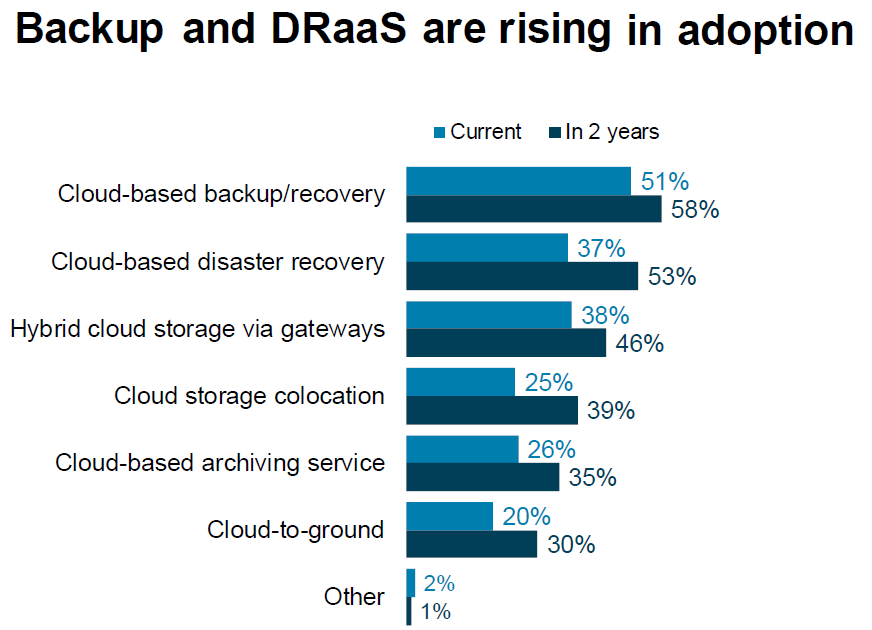
If you asked a group of enterprise infrastructure managers about their major pain points over the past couple of decades, one of their top responses would still be “too much data, not enough storage.” This is just one of the observations 451 Alliance members shared in an enterprise storage survey, the results of which were presented by Henry Baltazar, research director for the storage practice at 451 Research, at the webinar “Disaster Recovery & Data Management Push Storage to the Breaking Point.”
“It should be no surprise [that] data growth is still the top challenge,” said Baltazar, reporting that survey respondents “were expecting their data to grow by 28% for the next year… [including] 15% in the ‘significant increase’ bucket, where you’re growing over 50% per year.”

At the same time, while storage budgets are expected to increase in the coming 12 months, they will not support the growth necessary to house and manage the new data being generated at most enterprises.
“We need to make better use of [existing] resources to make sure that we’re handling this burden as it comes in,” Baltazar said. “It’s like the water is coming in faster, we need to have bigger buckets.”
Lax data management compounds the problem
Baltazar sees the problem of explosive data generation intensified by a lack of data retention policies – or non-adherence to any policies that do exist – at many organizations. More than three in 10 organizations lack data retention policies or don’t follow the ones they have, and 36% have no or poor data deletion practices.

Still, he understands why the data management conundrum exists. “If you talk to the stakeholders, they think all their data is important,” he said. “They’re not willing to give up any of their data, [and in] some cases, they may be right….” With AI, machine learning, analytics and trying to extract business value, there’s even more pressure to keep and hold onto data.
Traditional storage spending shifts toward cloud
Baltazar reported that “public cloud spending is cutting into on-premises budgets for 59% of respondents,” a trend propelled by the growing work-from-home movement, in which data is both generated and accessed in a wider range of locations. The storage survey showed that 61% of organizations use cloud storage at present, with another 29% either testing it now or planning to deploy it within the coming year.

Cloud storage may be on the rise, but Baltazar doesn’t expect it will fully supplant on-premises storage operations. Rather, a hybrid IT environment, featuring both on- and off-premises storage components, is likely where most organizations are headed.
“When we ask [survey respondents] about what the future is for storage infrastructure… 60% of them or so say they want to get to a true hybrid environment, where they have on-premises resources and they have cloud resources, but they have the ability to use them interchangeably.”
The survey showed several key hybrid cloud storage use cases, led by storage backup and disaster recovery. “Cloud-based disaster recovery is definitely another area we’re keeping a close eye on,” Baltazar noted, with “37% of you claiming to use it today, [a figure expected to jump] all the way up to 53% two years from now.”

A good problem to have
Throughout the presentation, Baltazar returned repeatedly to the fundamental issue of persistent data growth and the strain it places on storage systems. Ultimately, he offered a silver lining to the problem:
“You probably have more issues if your data is not growing,” he stated. “I don’t necessarily see data growth as a bad thing. [It] could be a function of how your business is transforming… of adding more applications… [or] due to technology changes.”
You probably have more issues if your data is not growing.
Henry Baltazar, 451 Research
So, as much as data growth poses a monumental challenge, “I would be more concerned if your data isn’t growing,” Baltazar concluded, “because that probably says more about the business than it says about your management of… the infrastructure.”
Baltazar covered other storage-related material in his webinar, including wide-ranging topics like containerized storage and the role of storage in surviving ransomware attacks. His presentation was part of the 451 Alliance’s monthly webinar series, which is available at no cost to IT professionals who participate in our quantitative surveys or qualitative interviews. A complete library of on-demand research products is available to Alliance members. Continued thanks to our members for sharing their knowledge with peers through their participation in our studies.
